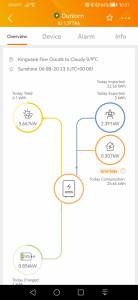Battery Charging Anomalies
I've a 5.6kW solar array plus 2x5kWh Puredrive batteries all talking via a Solis inverter. I had a problem recently with the batteries not charging. Puredrive came out and swapped a comms cable as apparently one of the batteries wasn't communicating with the inverter. This appeared to work and I've had a few days with good PV yield with the batteries getting up to high storage levels.
However, all is not well as the system seems to be exporting a large proportion of yield even when the battery charge is very low. Even with high PV outputs, the batteries appear to be only accepting <1kW charge power in the mornings (so most yield going straight to export) and then only starting to charge at an appreciable rate (ie 2-3.5kW) once the battery has reached around 40% capacity mid-pm. Today is a good example - as of 1400 I'd had 16kWh PV production but 6kWh had been exported with the battery only having reached 38%!
I've no idea why this should be. My memories of A level physics tells me the battery charge rate should be greater with a lower state of charge. I've referred this to my installer but does anyone else have experience of charging anomalies/excessive export and what was the cause?
2 x 12kW Samsung Gen6 ASHP, 5.6kW solar PV ground mounted c/w 10kWh Puredrive battery & Solis inverter.
Posted by: @dunlornMy memories of A level physics tells me the battery charge rate should be greater with a lower state of charge.
That isn't how your Puredrive batteries are being charged.
The charge current will be set by a micro-controller. It's configurable, and independent of the present State of Charge (SoC) of the batteries.
In your case, I believe that the Solis inverter 'manages' the process, and that the Puredrive batteries only contain the protection electronics, or BMS.
Unless the batteries are reporting that they are full, or that there's a fault, it will be the Solis inverter which controls the charge current.
The Solis inverter probably also connects to a meter on its mains connection. That monitors how much electricity is being used within the house, and how much exported to the grid.
That meter will also have a data/communications cable to the inverter.
There are just too many unknowns about your particular configuration for me to comment further.
I can't tell whether there's a genuine fault, or if you just have a data connection problem.
Save energy... recycle electrons!
Thanks @transparent, that's helpful. I'll pursue Solis for a fix.
When Puredrive came to fix the initial problem with batteries not accepting charge, they replaced a data cable as apparently an incorrect type had been used. It now makes me wonder if this is the case elsewhere.
The Solis inverter's readings for power consumed, imported etc also don't line up. The monthly power figures align with what the household meter is telling me but when you summate the individual daily readings over the month they are very different, around 9-10% less. Clearly the daily readings are under-reporting. I've reported this to Solis recently but it may all be connected I guess.
2 x 12kW Samsung Gen6 ASHP, 5.6kW solar PV ground mounted c/w 10kWh Puredrive battery & Solis inverter.
Every process which your electricity passes through will create a few percent loss.
Imagine that the inverter is 97% efficient at converting the input from solar panels to the 50v DC required by the Puredrive batteries.
Then there's the losses incurred within the chemistry of the battery cells.
This occurs twice:
- as the incoming charge current is stored
- as the cells discharge to supply electricity back to the inverter
Let's say 98% efficiency for each half of the process.
Finally, the inverter has to take that stored energy at 50v DC and convert it to 240v AC to power the house. That's less efficient - perhaps 96%
So if you start with 1kWh of solar energy, how much do you eventually get delivered to the house?
1000w x .97 x 0.98 x 0.98 x 0.96 = 894w
which means you're 'losing' about 10%.
Is that what you're seeing by adding totals together?
It all depends on where the measurements are being taken.
If the 'daily totals' are looking at the whole process (including battery storage and discharge), but the monthly total is mainly comprised of electricity being exported directly to the grid, then they'll certainly be different!
Save energy... recycle electrons!
The Solis inverter separately records whole house consumption, PV yield, imports, exports and battery storage. The 'monthly' imports figure aligns very well with what my household meter says but the summated daily values don't. Same issue with other parameters. I don't think this is to do with losses.
I raised a ticket via the Solis service centre on this power anomaly a while back. Yesterday they sent me a note to say it was fixed! Dunno what they've done and haven't been able to validate it yet so will see. The issue of the low battery charging/high exports is still being investigated.
2 x 12kW Samsung Gen6 ASHP, 5.6kW solar PV ground mounted c/w 10kWh Puredrive battery & Solis inverter.
Well I'm glad to see that you're obtaining some responses from Solis.
If they say that something has been 'fixed', how are they applying that 'fix' to their inverters, including yours?
Is there an internet link which allows them to download software into your inverter (without your knowledge)?
I spent 2 years on a trial of a different battery storage product. So I've become pretty familiar with how the manufacturers substantiate their claims.
I added my own external metering to check what was happening... which was most enlightening!
On the days when there was insufficient solar generation to allow any to be stored, the battery unit continued to take power from the grid in order to run its electronics and cooling fans.
Since this trial occurred partly during the 2022 energy crisis, I calculated I would be importing about £200 worth of electricity to feed the unit.
As it was a 'maintained' device, it relied on its live internet connection to operate. There were no meters or indicators on the product itself.
Perhaps that might give you a further clue as to where your losses might be showing on the daily statistics.
Save energy... recycle electrons!
Posted by: @dunlorn...
Even with high PV outputs, the batteries appear to be only accepting <1kW charge power in the mornings (so most yield going straight to export) and then only starting to charge at an appreciable rate (ie 2-3.5kW) once the battery has reached around 40% capacity mid-pm. Today is a good example - as of 1400 I'd had 16kWh PV production but 6kWh had been exported with the battery only having reached 38%!
...
Batteries controllers may limit their charging current when they are cold - this could be a factor depending on where your batteries are located.
A neighbour reports something very similar on his new system - still being investigated.
According to this from Powerwall website all batteries have this issue
"When temperatures are low, all batteries have a reduced ability to charge. To help Powerwall counteract this, Powerwall uses Preconditioning. When temperatures are below freezing, Preconditioning turns on and heats your Powerwall to improve operation and charging performance. To heat itself, Powerwall draws a small amount of energy, which then allows high-power charging.
During a cold night, your Powerwall automatically preheats before sunrise so that maximum solar energy can be captured during the day."
We are still in the early days of home storage unfortunately. It's all far more complicated than the brochures would have us believe.
Good luck
Our experiences with solar pv, ASHP, battery, and EV: ourhomeelectric.co.uk
Posted by: @steevjoWhen temperatures are low, all batteries have a reduced ability to charge.
@steevjo has rightly raised the issue of temperature, but I ought to qualify what Powerwall have stated:
Yes, lower temperatures decrease the rate of charge, but that's not the main problem which their product faces.
Powerwall are using LiFePO4 cells (Lithium Ferrous Phosphate). Charging that particular chemistry below 0°C can damage the cells.
The lithium cells used in most EVs, power-tools and laptops are LiMNC. They can be charged at lower temperatures, but are more expensive per kWh of capacity.
The next generation lithium cell technology for home storage may turn out to be Lithium Titanate (LTO). They can be charged satisfactorily as low as -40°C
Having said that, I dismissed low temperature as being the cause of the problems being reported here by @dunlorn
It wouldn't be sufficient to account for the volume of electricity being exported during the main part of the day.
By that time, the internal heaters in the Powerwall product would've sorted things out.
Save energy... recycle electrons!
Thanks for comments both.
I did wonder about temperature being a cause but it's not been below zero when it's happening. Today is a good example, it's bright currently with good PV output (c3.5kW) and an ambient temperature of about 6°C. The battery is only accepting 800W or so, with a small household load the majority is being given away to the grid. (Our smart meter doesn't function but that's a whole other story!). I've seen this on a few days and curiously the battery charge rate appears to be flat-lining, with modest increments every so often. Suggests to me that it's being controlled like this somehow.
Would reduced charging ability still be expected at these sorts of ambient temperature? If so this has quite an impact on the value of the batteries.
2 x 12kW Samsung Gen6 ASHP, 5.6kW solar PV ground mounted c/w 10kWh Puredrive battery & Solis inverter.
@dunlorn sorry really don’t know, temperature was just speculation on my part.
The way I think it works is that the battery sends info to the inverter about its state and the inverter uses that info to set the charge rate. If the charging rate increases later in the day then there’s something weird going on in the battery or in the inverter.
keep chasing your installer and good luck.
Our experiences with solar pv, ASHP, battery, and EV: ourhomeelectric.co.uk
I don't know the internals of the Tesla Powerwall, but from previous comments it would appear that the charging rate needs to be controlled when the cell temperatures are low.
I suspect that there may be a temperature sensor within the battery pack, and that the battery pack will have a degree of thermal mass, hence even when the ambient temperature may be 6C or above, the internal battery pack temperature may be several degrees lower than this.
If there should be heaters to keep the battery pack warm, are they actually switched on and working?
Probably questions for the Tesla Technical Helpline.
- 26 Forums
- 2,342 Topics
- 53 K Posts
- 303 Online
- 6,000 Members
Join Us!
Worth Watching
Latest Posts
-
RE: A Smarter Smart Controller from Homely?
@toodles that’s perfect, nothing like mine. Today mi...
By Papahuhu , 9 minutes ago
-

RE: Are We Sleepwalking Into Another Race to the Bottom?
@ksim Mathematicians have calculated that bees can’t fl...
By Toodles , 28 minutes ago
-

RE: Poll for Time of Use, tariffs, technology
That’s fine by me too Major, I feel it is a sad reflect...
By Toodles , 43 minutes ago
-
RE: Setback savings - fact or fiction?
I should have asked what does 'matched pairs' mean? Al...
By JamesPa , 1 hour ago
-

Bingo. Sometimes a judiciously placed size 10 bovver bo...
By Majordennisbloodnok , 1 hour ago
-
RE: Mitsubishi Ecodan 11.2kW heat pump with low COP
@ciocoiu-alexandru I can't provide the same level of di...
By Sheriff Fatman , 1 hour ago
-
RE: Configuring third party dongle for Ecodan local control
I think it would be a good education / experiment to gi...
By Sheriff Fatman , 2 hours ago
-
RE: Octopus Cosy Heat Pump Owners & Discussion Thread
Recently had my follow up with octopus for the vibratio...
By swwils , 3 hours ago
-

The three technical issues I'm considering are: BMS...
By Transparent , 4 hours ago
-
RE: LiFePO4 lithium battery fires and explosions
@transparent Your post may fit better in th...
By Batpred , 4 hours ago
-

RE: British Gas vs Octopus Energy vs Heat Geek vs EDF vs Aira vs OVO vs EON.Next vs Boxt
@jamespawhite, if you could be bothered, you could also...
By Mars , 6 hours ago
-
RE: Commencing on an ASHP Installation Process
I've got a bit of time to draft something today, so the...
By Sheriff Fatman , 21 hours ago
-
RE: Help with heat pump sizing
@amin I dont think materially relative to t...
By JamesPa , 23 hours ago
-

@majordennisbloodnok I have decided to take the plunge....
By TechnoGeek , 1 day ago
-
RE: Different dT on each radiator?
I cant sorry. Its based on some calculations I did fro...
By JamesPa , 2 days ago
-
RE: Help me keep the faith with my air source heat pump installation
@simonf thats interesting as I’ve noticed my flow and r...
By AdamK , 2 days ago
-

RE: MELcloud scheduling misbehaviour
No, it gets to set temperature easily even during perio...
By Abernyte , 2 days ago
-
RE: Free Ecoheat Heat Pump Install
Sorry hit 'add reply' too early, this forum layout will...
By Deltona , 2 days ago






